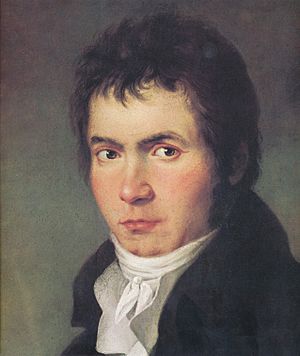Symphony No. 6 "Pastorale" (Beethoven) facts for kids
The Symphony No. 6 in F major, Op. 68, also known as the Pastorale Symphony, is a famous piece of music by Ludwig van Beethoven. He started working on ideas for this symphony in 1806. Beethoven finished composing it in 1808 while staying in a village called Heiligenstadt, which is near Vienna.
The first time the Pastorale Symphony was played for an audience was on December 22, 1808. This happened in Vienna, Austria, at the Theater an der Wien. It was a big concert where several of Beethoven's new works were performed. These included his famous Symphony No. 5 and his Piano Concerto No. 4.
Contents
What is the Pastorale Symphony?
The Pastorale Symphony is special because it tells a story through music. Beethoven gave each part of the symphony a descriptive title. These titles help listeners imagine scenes from the countryside. The symphony has five main parts, called movements.
The Five Movements
Each movement of the symphony describes a different scene or feeling related to nature.
Movement 1: Joyful Feelings Upon Arriving in the Country
The first movement is called "Joyful Feelings Upon Arriving in the Country" (Allegro ma non troppo). It uses a musical form called sonata form. This part of the symphony sounds calm and happy. It helps you imagine the composer's joy as he arrives in the peaceful countryside.
Movement 2: By the Brook
The second movement is titled "By the Brook" (Andante molto mosso). It is also in sonata form. In this movement, Beethoven included sounds of birds. He even wrote in the music which instruments should play which bird calls. The flute plays the sound of a nightingale. The oboe sounds like a quail. The clarinet imitates a cuckoo.
Movement 3: Peasant Merrymaking
The third movement is called "Peasant Merrymaking" (Allegro). This part is a scherzo, which means it's usually playful and fast. It paints a picture of country folk dancing and having fun. The music ends suddenly, as if the people notice that rain is starting to fall.
Movement 4: The Thunderstorm
The fourth movement is simply named "The Thunderstorm" (Allegro). This part of the symphony is very dramatic. It starts with just a few musical "raindrops." Then, it builds up to a powerful storm. You can hear musical thunder, lightning, strong winds, and heavy rain.
Movement 5: The Shepherd's Song After the Storm
The final movement is "The Shepherd's Song After the Storm" (Allegretto). This part uses a musical form called sonata rondo form. It begins right after the storm ends. The music sounds peaceful and thankful. It's like a shepherd singing a happy song after the bad weather has passed.
See also
Further Reading
- Woodstra, Chris, et. al. 2005. All Music Guide to Classical Music. Backbeat Books. p. 103. ISBN: 0-87930-865-6.
 In Spanish: Sinfonía n.º 6 (Beethoven) para niños
In Spanish: Sinfonía n.º 6 (Beethoven) para niños


